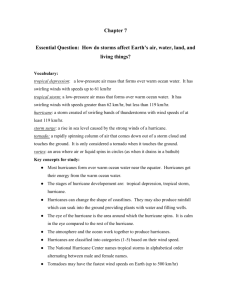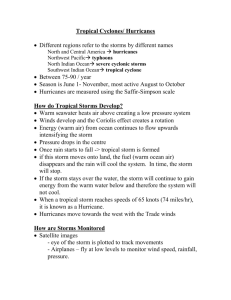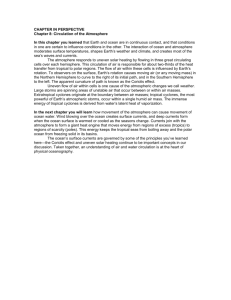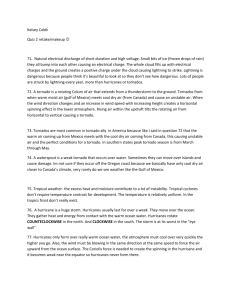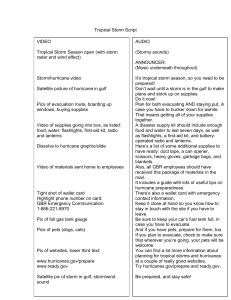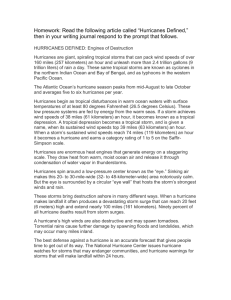The Ocean, Atmosphere & Weather
advertisement
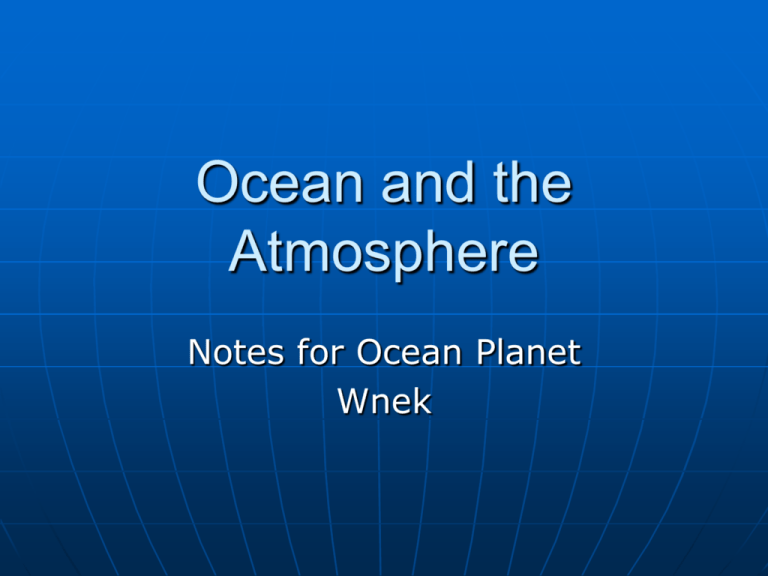
Ocean and the Atmosphere Notes for Ocean Planet Wnek Layers of the atmosphere The role of the atmosphere The atmosphere influences the ocean, especially through winddriven and density driven circulation Wind-driven circulation can cause a deflection of water off continents The wind-driven pattern can create coastal upwelling and downwelling patterns (discussed later) Earth’s Rotation Coriolis Effect Ekman Spiral The Motion of the earth can be up to 45 degrees to the right of the wind direction in the northern hemisphere and left in the southern hemisphere <> Upwelling Movement of water away from land (coasts) where it is replaced by colder water (nutrient rich) from deeper areas The movement of water away from the coast is called “divergence” In the northern hemisphere on the east coast of continents a southerly wind causes upwelling… Courtesy of NOAA 2004 Upwelling Schematic http://oceanservice.noaa.gov/education/kits/ currents/03coastal4.html Courtesy of NOAA 2004 The role of the wind Unequal heating of the atmosphere by the land and ocean surfaces Friction between the moving air and the ocean surface create surface currents Negating the rotation of the earth, the wind would cause surface currents to move, thus layers move below it causing a net movement Pacific Decadal Oscillation considered a climate index (Mantua et al. 1997; NOAA 2011) Increase in carbon dioxide levels between 1860 and 1990. Image from Purves et al., Life: The Science of Biology, 4th Edition, by Sinauer Associates (www.sinauer.com) and WH Freeman (www.whfreeman.com). Are Ice Cores Accurate? It is difficult to believe that a chemically active gas such as carbon dioxide can remain unaffected by burial in ice for as long as 160,000 years. There are questions whether the carbon dioxide can diffuse through the snow, react with dust particles, or form clathrate compounds under pressure The technique of drilling, removal and preservation of the ice core is very difficult, and there are many things that can go wrong (Jaworski, 1996, 1997). Findings The period since 1972, when the increase has been linear despite an increase of over 45% in emissions, suggests that there are new carbon sinks being established in the ocean and in the terrestrial biosphere to absorb the increases (Gray, 1998). Sea Level Rise Global mean sea level has been rising at an average rate of 1 to 2 mm/year over the past 100 years, which is significantly larger than the rate averaged over the last several thousand years. Projected increase from 1990-2100 is anywhere from 0.09-0.88 meters (depending on the severity of the warming) Ocean Currents? Illustration by Jack Cook, Woods Hole Oceanographic Institution This is now being reconsidered in terms of the rate of slowing Coupled ocean-atmospheric models Rising carbon dioxide indicate upperocean stratification Stability will increase & mixing will decrease the next 50 years Net primary productivity (NPP) of microplankton will increase and megaplankton will decrease (Barber 2007) The Future Precipitation is also expected to increase over the 21st century, particularly at northern mid-high latitudes, though the trends may be more variable in the tropics. Snow extent and sea-ice are also projected to decrease further in the northern hemisphere, and glaciers and ice-caps are expected to continue to retreat. Weather and the Ocean Pressure Gradients Air is constantly moving to seek an equilibrium between areas of more air molecules (higher pressure) and those with less (lower pressure). Wind is nothing more than the movement of air molecules from one place to the next. The direction and speed of the wind represents the balance between three basic forces acting on it: the pressure gradient, the Coriolis force, and surface friction. Pressures are trying to stay in balance. Pressures are reported in Isobars Isobars What is a jet stream? It is an area with significant pressure differences within a 9 km band It generally moves from west to east and is more substantial in from 20,000 feet or higher Can move in speeds greater than 200 mph Can dip down in the winter as a result of sinking cold air from the north NOAA.gov Tropical Systems Defined as low pressure systems that have a counterclockwise rotation in the northern hemisphere & the opposite in the southern hemisphere The opposite rotation in each hemisphere is due to the Coriolis Effect They are all CYCLONES; however they are called HURRICANES in the western hemisphere and strong storms are TYPHOONS in the eastern hemisphere Formed by storms, Intertropical Convergent Zone areas Tropical Cyclones For a cyclone to form, the ocean waters need to be warm, at least 26°C. Above the warm ocean, water evaporates and form clouds. If there is low air pressure where the clouds are formed, it pulls them in and they begin to rotate. If a storm achieves wind speeds of 38 miles (61 kilometers) an hour, it becomes known as a tropical depression. Hurricanes spin around a low-pressure center known as the “eye.” Sinking air makes this 20to 30-mile-wide (32- to 48-kilometer-wide) area notoriously calm. But the eye is surrounded by a circular “eye wall” that hosts the storm’s strongest winds and rain. NASA.gov http://www.cyclonerita.com/hurricane-irene.html Scale to determine the strength of tropical cyclones 1 knot = 1.15 miles/hour Storm Designations The Saffir-Simpson Hurricane Wind Scale is a 1 to 5 categorization based on the hurricane's intensity at the indicated time. Where do tropical cyclones come from and when? Most hurricanes begin in the Atlantic as a result of tropical waves that move westward off the African coast. Official Hurricane season is June 1 – November 30 each year. Many early and late Atlantic Ocean Hurricanes originate in the Gulf of Mexico or Caribbean Intertropical Convergence Zone Intertropical Convergence Zone Tropical Activity as of September 4, 2011 (Weather Underground) Weather underground. com Hurricane Irene (NASA 2011) Hurricane Sandy 2012 Problems Associated with Tropical Cyclones Winds Storm Surge Flooding Storm Surge Can Devastate Marinas Hurricane Irene Storm Surge at New Bourne, NC Storm Surge in Bayside Long Island from Hurricane Irene Pier at Atlantic Beach, NC Hurricanes: The Most Powerful on Record (Lowest Pressures) Ranking Storm ID Storm Name Origin Date Minimum Central Pressure (in mb.) 1 1347 WILMA 2005-10-15 882 2 1122 GILBERT 1988-09-08 888 3 615 UNNAMED 1935-08-29 892 4 1342 RITA 2005-09-18 897 5 1045 ALLEN 1980-07-31 899 6 1336 KATRINA 2005-08-23 902 7 934 CAMILLE 1969-08-14 905 8 1234 MITCH 1998-10-22 905 9 1383 DEAN 2007-08-13 907 10 1314 IVAN 2004-09-02 910 11 815 JANET 1955-09-21 914 12 1298 ISABEL 2003-09-06 915 13 1134 HUGO 1989-09-10 918 14 1196 OPAL 1995-09-27 919 15 1097 GLORIA 1985-09-16 920 16 870 HATTIE 1961-10-27 920 17 1241 FLOYD 1999-09-07 921 18 1161 ANDREW 1992-08-16 922 19 917 BEULAH 1967-09-05 923 20 14 UNNAMED 1853-08-30 924 Sandy was 940 mb at landfall, which is lowest north of NC ever! Nor’easters Nor’easter These strong areas of low pressure often form either in the Gulf of Mexico or off the East Coast in the Atlantic Ocean. The low will then either move up the East Coast into New England and the Atlantic provinces of Canada or out to sea. Detailed studies taken from satellite imagery and other readings suggest that some low pressure systems associated with nor'easters may develop tropical storm characteristics such as an eye in the center of the low. El Nino El Niños are not caused by global warming. However, it has been hypothesized that warmer global sea surface temperatures can enhance the El Niño phenomenon, and it is also true that El Niños have been more frequent and intense in recent decades. La Nina 1998-1999 dnr.sc.gov El Nino and its impacts on the Leatherback Sea Turtle in Costa Rica All of the pictures and graphics were provided by Dr. James Spotila, Drexel University and the Leatherback Trust Leatherback Jelly-vore The turtle all the other biologists wish they could study Results- counting turtles 1719 turtles have been tagged in 11 years 448 have returned to nest again Annual mortality rates 22% 22%!! Leatherbacks in the Pacific 1980- 91,000 adult females 1995- 6,500 adult females 2000- 3,490 adult females East Pacific- 1995- 4638 2000- 1690 2006- 800 Exponential Decline 1504 1474 1400 1200 1000 1000 847 732 800 569 600 421 417 400 246 234 195 200 140 188 126 79 68 54 124 Season Parque Nacional Marino Las Baulas, Costa Rica /0 6 05 /0 5 04 /0 4 03 /0 3 02 /0 2 01 /0 1 00 /0 0 99 /9 9 98 /9 8 97 /9 7 96 /9 6 95 /9 5 94 /9 4 93 /9 3 92 /9 2 91 /9 1 90 /9 0 89 /8 9 0 88 Number of nesting turtles turtles 1600 Climatic variables may play a major role in influencing return interval and apparent population size Beach Profile at Marker #16 Normal Dune elevation has a berm but with development the berm is destroyed 4.00 Meters above Mean Sea Level 3.50 3.00 2.50 2.00 1.50 1.00 0.50 53 50 47 43 40 37 33 30 27 23 20 17 13 10 7 3 0 0.00 Distance (m) Beach Profile at Marker #31 Beach Profile for Marker #1 4.00 3.00 3.50 Meters above Mean Sea Level 3.50 2.50 2.00 1.50 1.00 0.50 3.00 2.50 2.00 1.50 1.00 0.50 0.00 Distance (m) Distance in Meters 70 67 63 60 57 53 50 47 43 40 37 33 30 27 23 20 17 13 10 7 3 0 53 50 47 43 40 37 33 30 27 23 20 17 13 10 7 0.00 3 0 Meters above Mean Sea Level 4.00 Threats Fishing Longlines Gill Nets Shrimp Nets Poaching Eggs Adults Loss of Nesting Beaches No nesting beaches = no turtles • Longlining for swordfish and tuna is one of the most significant threats to sea turtles Longlines stretch as much as 60 miles and have thousands of baited hooks ~1.4 billion longline hooks in the oceans each year Graphic: Sea Turtle Restoration Project The Great BP Oil Spill The large strands of sargassum seaweed atop the ocean are normally noisy with birds and thick with crustaceans, small fish and sea turtles. But now this is a silent panorama, heavy with the smell of oil. There are no birds. The seaweed is soaked in rust-colored crude and chemical dispersant. It is devoid of life except for the occasional juvenile sea turtle, speckled with oil and clinging to the only habitat it knows. Thick ribbons of oil spread out through the sea like the strips in egg flower soup, gorgeous and deadly. Loss of 10 years of sea turtle conservation- Effects for a generation Boiling the turtles alive! References Barber, R.T. 2007. Picoplankton do some heavy lifting. Science, February 9: pp. 777-778. Etheridges, D.M., L.P. Steele, R.L. Langenfelds, R.J. Francey, J.-M Barnola, V.I. Morgan. 1996. "Natural and anthropogenic changes in atmospheric CO2 over the last 1000 years from air in Antarctic ice and firn" J. Geophys. Res. 101 (D2) 4115-4128 Etheridges, D.M., L.P. Steele, R.L. Langenfelds, R.J. Francey, J.-M Barnola, V.I. Morgan. 1996. "Natural and anthropogenic changes in atmospheric CO2 over the last 1000 years from air in Antarctic ice and firn" J. Geophys. Res. 101 (D2) 4115-4128 Gray, V.R., 1998. "The IPCC future projections: are they plausible" Climate Research 10 155-162 http://palaeo.gly.bris.ac.uk/Palaeofiles/Permian/PALIntro.html http://www.ncdc.noaa.gov/oa/climate/globalwarming.html#Q11 Jaworowski, Z. 1996 "Reliability of Ice Core Records for Climatic Projections" in "The Global Warming Debate", (John Emsley, Ed.) European Science and Environment Forum , London, 95-105. Jaworowski, Z., 1997. "Ice Core Data Show No Carbon Dioxide Increase" 21st Century Science and Technology 10 , (1) 42-52
